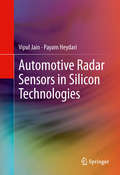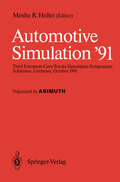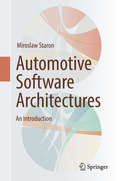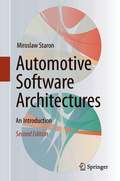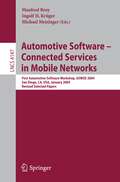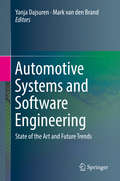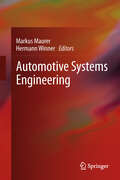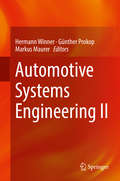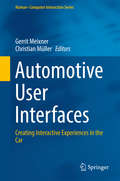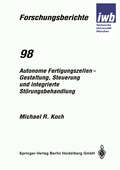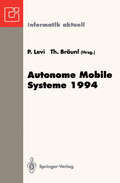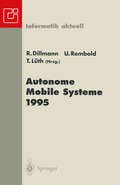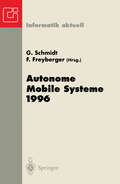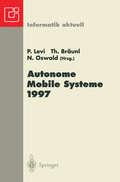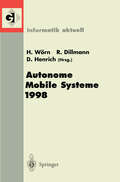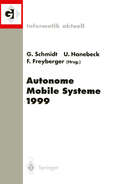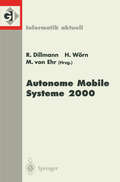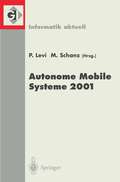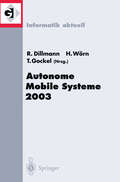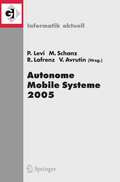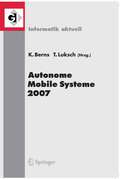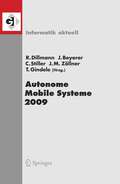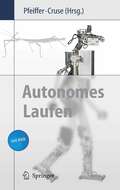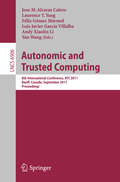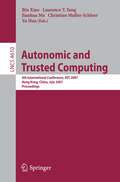- Table View
- List View
Automotive Radar Sensors in Silicon Technologies
by Vipul Jain Payam HeydariOne of the leading causes of automobile accidents is the slow reaction of the driver while responding to a hazardous situation. State-of-the-art wireless electronics can automate several driving functions, leading to significant reduction in human error and improvement in vehicle safety. With continuous transistor scaling, silicon fabrication technology now has the potential to substantially reduce the cost of automotive radar sensors. This book bridges an existing gap between information available on dependable system/architecture design and circuit design. It provides the background of the field and detailed description of recent research and development of silicon-based radar sensors. System-level requirements and circuit topologies for radar transceivers are described in detail. Holistic approaches towards designing radar sensors are validated with several examples of highly-integrated radar ICs in silicon technologies. Circuit techniques to design millimeter-wave circuits in silicon technologies are discussed in depth.
Automotive Simulation ’91: Proceedings of the 3rd European Cars/Trucks, Simulation Symposium Schliersee, Germany, October 1991
by Moshe R. HellerWelcome to Bavaria - Germany - to the THIRD EUROPEAN CARS/TRUCKS SIMULATION SYMPOSIUM. That Schliersee traditional workshop-type meeting is a follow-up to the first and the second symposia which took place in May 1984 and May 1989 respectively. The objective of gathering together is to cover most of the aspects of Automotive Mathematical Modelling and Simulation in theory and practice to promote the exchange of knowledge and experience between different national and international research groups in that field, taking into consideration that every seventh German employee is related to the automotive industry. This effect is also in power at least with the traditional Detroit (U.S.A.) Automotive Industries and the growing up Japanease as well. Futhermore, there is to strenghten the international contact between developers and users of modelling and simulation techniques considering the "new world order" started in 1991 with no borders between West and East affected by the Golf-War and followed up by the "open" European Community borders of 1992. VI The traditional International Conference jointly promoted by ASIMUTH - Applied Simulation Technology and some other members of the Society of Computer Simulaton created an interest to publish new projects including their results. A large number of contributed papers has been strictly examined and selected by the editorial commitee to guarantee a high international technical standard.
Automotive Software Architectures: An Introduction
by Miroslaw StaronThis book introduces the concept of software architecture as one of the cornerstones of software in modern cars. Following a historical overview of the evolution of software in modern cars and a discussion of the main challenges driving that evolution, Chapter 2 describes the main architectural styles of automotive software and their use in cars’ software. In Chapter 3, readers will find a description of the software development processes used to develop software on the car manufacturers’ side. Chapter 4 then introduces AUTOSAR – an important standard in automotive software. Chapter 5 goes beyond simple architecture and describes the detailed design process for automotive software using Simulink, helping readers to understand how detailed design links to high-level design. Next, Chapter 6 presents a method for assessing the quality of the architecture – ATAM (Architecture Trade-off Analysis Method) – and provides a sample assessment, while Chapter 7 presents an alternative way of assessing the architecture, namely by using quantitative measures and indicators. Subsequently Chapter 8 dives deeper into one of the specific properties discussed in Chapter 6 – safety – and details an important standard in that area, the ISO/IEC 26262 norm. Lastly, Chapter 9 presents a set of future trends that are currently emerging and have the potential to shape automotive software engineering in the coming years.This book explores the concept of software architecture for modern cars and is intended for both beginning and advanced software designers. It mainly aims at two different groups of audience – professionals working with automotive software who need to understand concepts related to automotive architectures, and students of software engineering or related fields who need to understand the specifics of automotive software to be able to construct cars or their components. Accordingly, the book also contains a wealth of real-world examples illustrating the concepts discussed and requires no prior background in the automotive domain.
Automotive Software Architectures: An Introduction
by Miroslaw StaronThis book introduces the concept of software architecture as one of the cornerstones of software in modern cars. Following a historical overview of the evolution of software in modern cars and a discussion of the main challenges driving that evolution, Chapter 2 describes the main architectural styles of automotive software and their use in cars’ software. Chapter 3 details this further by presenting two modern architectural styles, i.e. centralized and federated software architectures. In Chapter 4, readers will find a description of the software development processes used to develop software on the car manufacturers’ side. Chapter 5 then introduces AUTOSAR – an important standard in automotive software. Chapter 6 goes beyond simple architecture and describes the detailed design process for automotive software using Simulink, helping readers to understand how detailed design links to high-level design. The new chapter 7 reports on how machine learning is exploited in automotive software e.g. for image recognition and how both on-board and off-board learning are applied. Next, Chapter 8 presents a method for assessing the quality of the architecture – ATAM (Architecture Trade-off Analysis Method) – and provides a sample assessment, while Chapter 9 presents an alternative way of assessing the architecture, namely by using quantitative measures and indicators. Subsequently Chapter 10 dives deeper into one of the specific properties discussed in Chapter 8 – safety – and details an important standard in that area, the ISO/IEC 26262 norm. Lastly, Chapter 11 presents a set of future trends that are currently emerging and have the potential to shape automotive software engineering in the coming years. This book explores the concept of software architecture for modern cars and is intended for both beginning and advanced software designers. It mainly aims at two different groups of audience – professionals working with automotive software who need to understand concepts related to automotive architectures, and students of software engineering or related fields who need to understand the specifics of automotive software to be able to construct cars or their components. Accordingly, the book also contains a wealth of real-world examples illustrating the concepts discussed and requires no prior background in the automotive domain. Compared to the first edition, besides the two new chapters 3 and 7 there are considerable updates in chapters 5 and 8 especially.
Automotive Software-Connected Services in Mobile Networks: First Automotive Software Workshop, ASWSD 2004, San Diego, CA, USA, January 10-12, 2004, Revised Selected Papers (Lecture Notes in Computer Science #4147)
by Manfred Broy Ingolf Krüger Michael MeisingerThis book constitutes the thoroughly refereed post-proceedings of the First Automotive Software Workshop, ASWD 2004, held in San Diego, CA, USA in January 2004. The 10 revised full papers presented were carefully reviewed and selected from 26 lectures held at the workshop that brought together experts from industry and academia, working on highly complex, distributed, reactive software systems related to the automotive domain.
Automotive Systems and Software Engineering: State of the Art and Future Trends
This book presents the state of the art, challenges and future trends in automotive software engineering. The amount of automotive software has grown from just a few lines of code in the 1970s to millions of lines in today’s cars. And this trend seems destined to continue in the years to come, considering all the innovations in electric/hybrid, autonomous, and connected cars. Yet there are also concerns related to onboard software, such as security, robustness, and trust.This book covers all essential aspects of the field. After a general introduction to the topic, it addresses automotive software development, automotive software reuse, E/E architectures and safety, C-ITS and security, and future trends. The specific topics discussed include requirements engineering for embedded software systems, tools and methods used in the automotive industry, software product lines, architectural frameworks, various related ISO standards, functional safety and safety cases, cooperative intelligent transportation systems, autonomous vehicles, and security and privacy issues.The intended audience includes researchers from academia who want to learn what the fundamental challenges are and how they are being tackled in the industry, and practitioners looking for cutting-edge academic findings. Although the book is not written as lecture notes, it can also be used in advanced master’s-level courses on software and system engineering. The book also includes a number of case studies that can be used for student projects.
Automotive Systems Engineering
by Markus Maurer and Hermann WinnerThis book reflects the shift in design paradigm in automobile industry. It presents future innovations, often referred as “automotive systems engineering”. These cause fundamental innovations in the field of driver assistance systems and electro-mobility as well as fundamental changes in the architecture of the vehicles. New driving functionalities can only be realized if the software programs of multiple electronic control units work together correctly. This volume presents the new and innovative methods which are mandatory to master the complexity of the vehicle of the future.
Automotive Systems Engineering II
by Hermann Winner Günther Prokop Markus MaurerThis book is the second volume reflecting the shift in the design paradigm in automobile industry. It presents contributions to the second and third workshop on Automotive Systems Engineering held in March 2013 and Sept. 2014, respectively.It describes major innovations in the field of driver assistance systems and automated vehicles as well as fundamental changes in the architecture of the vehicles.
Automotive User Interfaces: Creating Interactive Experiences in the Car (Human–Computer Interaction Series)
by Gerrit Meixner Christian MüllerThis book focuses on automotive user interfaces for in-vehicle usage, looking at car electronics, its software of hidden technologies (e.g., ASP, ESP), comfort functions (e.g., navigation, communication, entertainment) and driver assistance (e.g., distance checking). The increased complexity of automotive user interfaces, driven by the need for using consumer electronic devices in cars as well as autonomous driving, has sparked a plethora of new research within this field of study. Covering a broad spectrum of detailed topics, the authors of this edited volume offer an outstanding overview of the current state of the art; providing deep insights into usability and user experience, interaction techniques and technologies as well as methods, tools and its applications, exploring the increasing importance of Human-Computer-Interaction (HCI) within the automotive industry Automotive User Interfaces is intended as an authoritative and valuable resource for professional practitioners and researchers alike, as well as computer science and engineering students who are interested in automotive interfaces.
Autonome Fertigungszellen — Gestaltung, Steuerung und integrierte Störungsbehandlung (iwb Forschungsberichte #98)
by Michael R. KochAutonome Mobile Systeme 1994: 10. Fachgespräch, Stuttgart, 13. und 14. Oktober 1994 (Informatik aktuell)
by Paul Levi Thomas BräunlAutonome Mobile Systeme 1995: 11. Fachgespräch Karlsruhe, 30. November-1. Dezember 1995 (Informatik aktuell)
by Rüdiger Dillmann Ulrich Rembold Tim LüthAutonome Mobile Systeme 1996: 12. Fachgespräch München, 14.–15. Oktober 1996 (Informatik aktuell)
by Günther Schmidt Franz Freybergermit Sonderbeiträgen zu den technischen Demonstrationen aus dem Sonderforschungsbereich 331 "Informationsbearbeitung in autonomen, mobilen Handhabungssystemen" an der Technischen Universität München
Autonome Mobile Systeme 1997: 13. Fachgespräch, Stuttgart, 6.–7. Oktober 1997 (Informatik aktuell)
by Paul Levi Thomas Bräunl Norbert OswaldDas Werk bietet einen Überblick über die aktuelle Forschung auf dem Gebiet der Robotik. Das Spektrum reicht von neuen Anwendungen von Servicerobotern bis zur Analyse von Multirobotersystemen, bei denen Aspekte der Kooperation und Simulation im Vordergrund stehen.
Autonome Mobile Systeme 1998: 14. Fachgespräch Karlsruhe, 30. November-1. Dezember 1998 (Informatik aktuell)
by Heinz Wö Rüdiger Dillmann Dominik HenrichVor 13 Jahren fand im November 1985 an der Universität Karlsruhe erstmals das Fachgespräch über "Autonome Mobile Systeme" statt. Seither wird es regelmäßig jedes Jahr alternierend einmal in München, Karlsruhe und seit 1994 auch in Stuttgart abgehalten. Diese Tradition entwickelte sich insbesondere durch Forschungs schwerpunkte, Verbundprojekte und Sonderforschungsbereiche, die an diesen Universitäten zu dem Thema autonome Systeme bearbeitet wurden, aktuell laufen oder in Planung sind. Im Dezember 1998 findet das 14. Fachgespräch "Autonome Mobile Systeme" (AMS'98) nunmehr das siebte Mal in Karlsruhe statt. Das Fachgespräch versteht sich als kritisches wissenschaftliches Forum im deutschsprachigen Raum, auf dem Arbeiten aus Universitäten und Fachhochschulen, Forschungseinrichtungen und Firmen auf dem Gebiet der autonomen mobilen Robotersysteme vorgestellt, diskutiert und neue Ideen aufgegriffen werden. Mit Freude können die Veranstalter darauf verweisen, daß auch internationale Gäste in das Fachgespräch eingebunden werden konnten. Bei den bisherigen Fachgesprächen zeigte sich deutlich, daß sich der Begriff der Autonomie von Robotersystemen ständig ändert und von den Anforderungen der jeweiligen Anwendung geprägt wird. Zu Beginn der Fachgesprächsreihe standen autonome Fahrzeuge in industriellen Produktionsbereichen im Vordergrund. Im Jahr 1998 zeigt das Spektrum der Beiträge, daß Autonomie auch ein Grundbestandteil von Straßen-, Gelände- Wasser- und Luftfahrzeugen wird. Die Forschung auf dem Gebiet autonomer mobiler Roboter konzentriert sich zunehmend auf den Bereich Serviceroboter. So wurden auf der Hannover-Messe in diesem Jahr auf dem Gemeinschaftsstand Serviceroboter zahlreiche mobile Plattformen für Roboteranwendungen in unterschiedlichen Dienstleistungsbereichen wie Büro, Hotel, Krankenhaus und gar im privaten Umfeld vorgestellt.
Autonome Mobile Systeme 1999: 15. Fachgespräch München, 26.–27. November 1999 (Informatik aktuell)
by Günther Schmidt Uwe Hanebeck Franz FreybergerAutonome Mobile Systeme 2000: 16. Fachgespräch Karlsruhe, 20./21. November 2000 (Informatik aktuell)
by Rüdiger Dillmann Heinz Wö Markus Von EhrAutonome Mobile Systeme 2001: 17. Fachgespräch Stuttgart, 11./12. Oktober 2001 (Informatik aktuell)
by Paul Levi Michael SchanzDie stetige Weiterentwicklung von Methoden und Konzepten der Sensorfusion, der künstlichen und verteilten künstlichen Intelligenz sowie die Innovationen auf dem Gebiet der Sensorik und Aktorik und die kontinuierlich zunehmende Performanz und Miniaturisierung der Rechnersysteme führen zu immer neuen Einsatzfeldern autonomer mobiler Systeme. Daher werden solche Systeme nicht nur in den mittlerweile traditionellen Bereichen wie Konstruktion, Fertigung, Logistik, Service und Behindertenunterstützung eingesetzt, sondern auch in relativ neuen Bereichen, beispielsweise auf dem Gebiet der autonomen Fahrzeuge oder der autonomen Spielzeuge.Ziel dieser Fachgespräche ist, Wissenschaftlern aus Forschung und Industrie, die auf dem Gebiet der autonomen mobilen Systeme arbeiten, eine Basis für den Gedanken- und Ideenaustausch zu bieten und wissenschaftliche Diskussionen sowie Kooperationen auf diesem Forschungsgebiet zu fördern.
Autonome Mobile Systeme 2003: 18. Fachgespräch Karlsruhe, 4./5. Dezember 2003 (Informatik aktuell)
by Rüdiger Dillmann Heinz Wö Tilo GockelDas 18. Fachgespräch "Autonome Mobile Systeme (AMS 2003)" ist ein Forum, in dem die neuesten Entwicklungen auf dem Gebiet wissenschaftlicher und industrieller autonomer Robotersysteme vorgestellt werden. Die Beiträge zu den Schwerpunkten Autonome Systeme im Straßenverkehr, Autonome und kooperative Systeme, Industrielle Systeme, Flug- und Unterwassersysteme, Bildverarbeitung, Planungsverfahren, Anwendungen und ihr Einsatz in Fertigung, Service, Reinigung, Entertainment, Infotainment und Edutainment, sowie Verhaltensbasierte KI u.a. bilden den Inhalt dieses Bandes.
Autonome Mobile Systeme 2005: 19. Fachgespräch Stuttgart, 8./9. Dezember 2005 (Informatik aktuell)
by Paul Levi Michael Schanz Reinhard Lafrenz Viktor AvrutinDas 19. Fachgespräch Autonome Mobile Systeme (AMS 2005) ist ein Forum, das Wissenschaftlerinnen und Wissenschaftlern aus Forschung und Industrie, die auf dem Gebiet der autonomen mobilen Systeme arbeiten, eine Basis für den Gedakenaustausch bietet und wissenschfltiche Diskussionen sowie Kooperationen auf diesem Forschungsgebiet fördert bzw. initiiert. Ausgewählte Beiträge zu den Themen Kooperative Systeme, Bildverarbeitung, Lokalisierung und Kartographierung, Outdoor-Systeme, Fahrerassistenzsysteme, Kognitive Sensordatenverarbeitung, Architekturen und Anwendungen sowie Steuerung und Navigation bilden den Inhalt dieses Bandes.
Autonome Mobile Systeme 2007: 20. Fachgespräch Kaiserslautern, 18./19. Oktober 2007 (Informatik aktuell)
by Karsten Berns Tobias LukschAusgewählte Beiträge zu aktuellen Themen: Das 20. Fachgespräch Autonome Mobile Systeme (AMS 2007) ist ein Forum für Wissenschaftler/innen aus Forschung und Industrie, die auf dem Gebiet der autonomen mobilen Systeme arbeiten. Es bietet Raum für Gedankenaustausch und Diskussion und fördert bzw. initiiert Kooperationen auf diesem Forschungsgebiet. Das diesjährige Fachgespräch beschäftigt sich hauptsächlich mit dem Bereich der kognitiven Automobile und Laufmaschinen.
Autonome Mobile Systeme 2009: 21. Fachgespräch Karlsruhe, 3./4. Dezember 2009 (Informatik aktuell)
by Marius Zöllner Tobias Gindele Rüdiger Dillmann Jürgen Beyerer Christoph StillerDer Band dokumentiert das 21. Fachgespräch Autonome Mobile Systeme (AMS 2009). Die Veranstaltung bietet Wissenschaftlern aus Forschung und Industrie ein Forum für den Gedankenaustausch und eine Basis, um Kooperationen auf diesem Forschungsgebiet zu initiieren. Die Beiträge befassen sich mit Themen wie humanoide Roboter und Flugmaschinen, Perzeption und Sensorik, Kartierung und Lokalisation, Regelung, Navigation, Lernverfahren, Systemarchitekturen sowie mit der Anwendung von autonomen mobilen Systemen.
Autonomes Laufen
by Friedrich Pfeiffer Holk CruseLaufen ist eine der genialsten Erfindungen der Natur. Aber erst in neuerer Zeit haben sich Technologien entwickelt, die den erfolgreichen Bau von autonomen Laufmaschinen realistisch erscheinen lassen. Dieses Buch beinhaltet die Ergebnisse des DFG Schwerpunktprogramms SPP1039 "Autonomes Laufen" – entstanden aus einer intensiven Zusammenarbeit einiger der führenden Ingenieure, Biologen und Informatiker auf diesem Gebiet. Es werden technische Realisierungen von Laufmaschinen ebenso präsentiert wie neueste biologische Erkenntnisse, deren Ergebnisse unmittelbar in solche technischen Umsetzungen einfließen. Dazu gehören Probleme der topologischen Strukturen des Laufens, der zum Laufen notwendigen Regelungen und Steuerungen und den damit verbundenen Fragen der Sensoren und der Aktoren, die Modellierung der Dynamik sowie die Auslegung und der Bau von Laufmaschinen. Eine dazugehörende und professionell umgesetzte DVD gibt einen vergnüglichen Überblick der Forschungsergebnisse und der dahinter stehenden Probleme.
Autonomic and Trusted Computing: 8th International Conference, ATC 2011, Banff, Canada, September 2-4, 2011, Proceedings (Lecture Notes in Computer Science #6906)
by Jose M. Alcaraz Calero Laurence T. Yang Felix Gomez-Marmol Luis Javier García Villalba Andy Xiaolin Li Yan WangThis book constitutes the refereed proceedings of the 8th International Conference on Autonomic and Trusted Computing, ATC 2011, held in Banff, Canada, September 2011. The 17 revised full papers presented together with 1 keynote speech were carefully reviewed and selected from numerous submissions. The papers address all current issues in autonomic architectures, models and systems, autonomic communications, trusted and secure computing, reliable, secure and trust applications.
Autonomic and Trusted Computing: 4th International Conference, ATC 2007, Hong Kong, China, July 11-13, 2007, Proceedings (Lecture Notes in Computer Science #4610)
by Yu Hua Bin Xiao Laurence T. Yang Christian Muller-SchloerNo fewer than 55 revised full papers are presented in this volume, all given at the 4th International Conference on Autonomic and Trusted Computing, held in Hong Kong, China in July 2007. The papers, presented together with one keynote lecture, were carefully reviewed and selected from 223 submissions. The papers are organized in topical sections on, among others, cryptography and signatures, autonomic computing and services, and secure and trusted computing.
